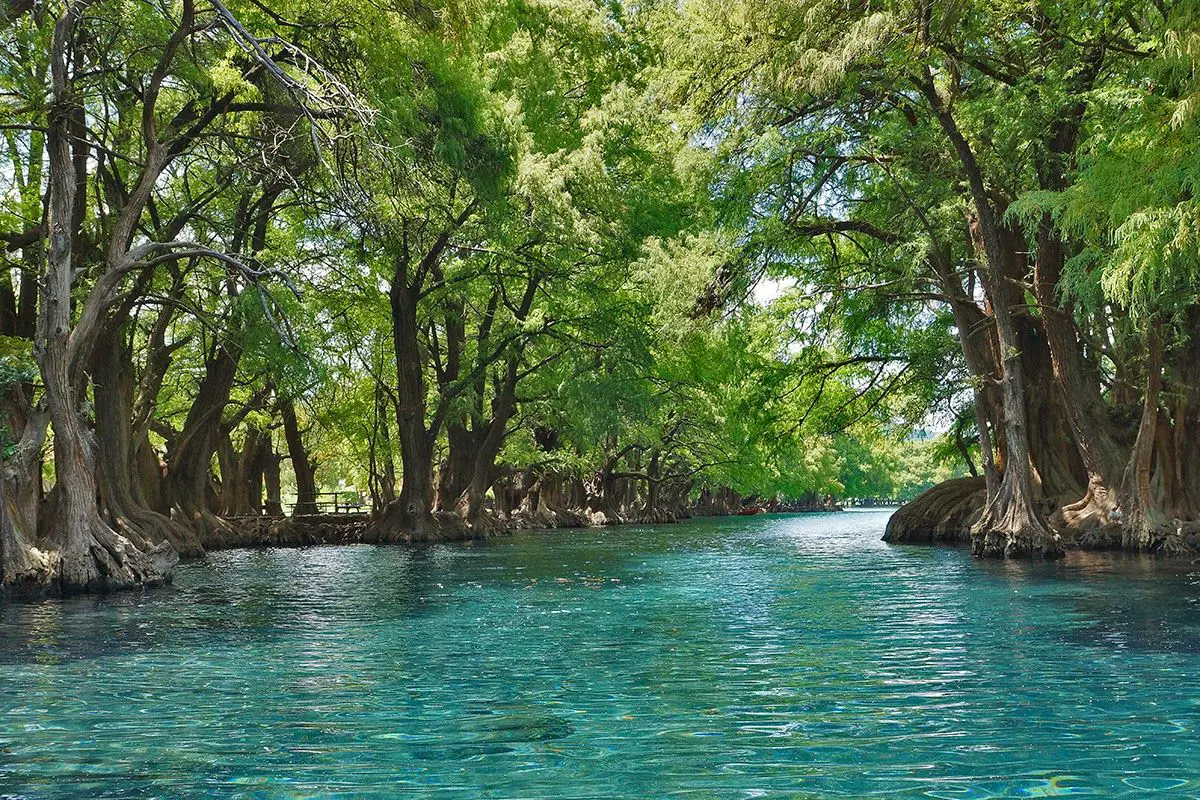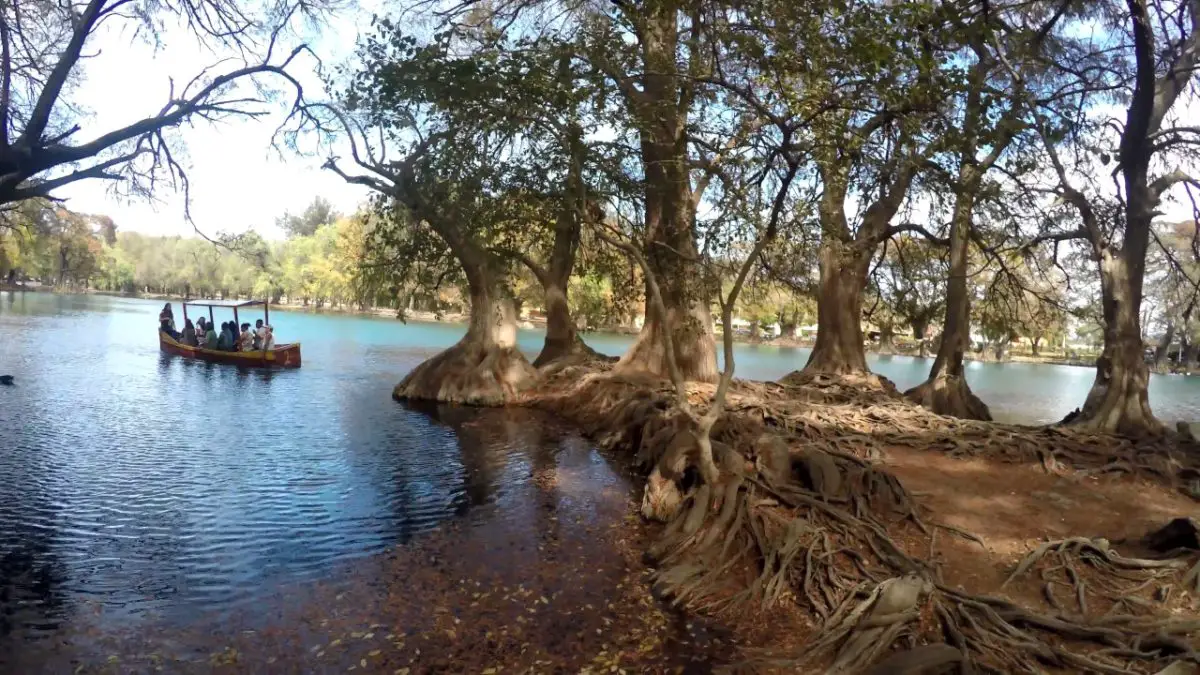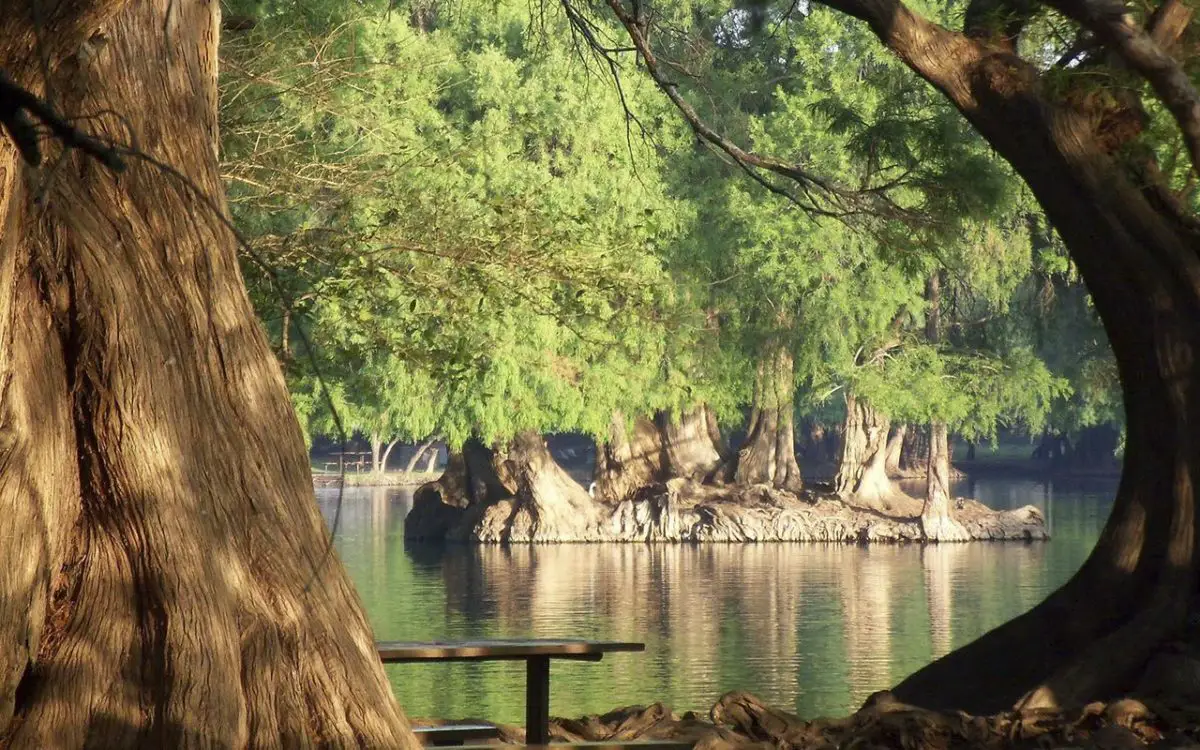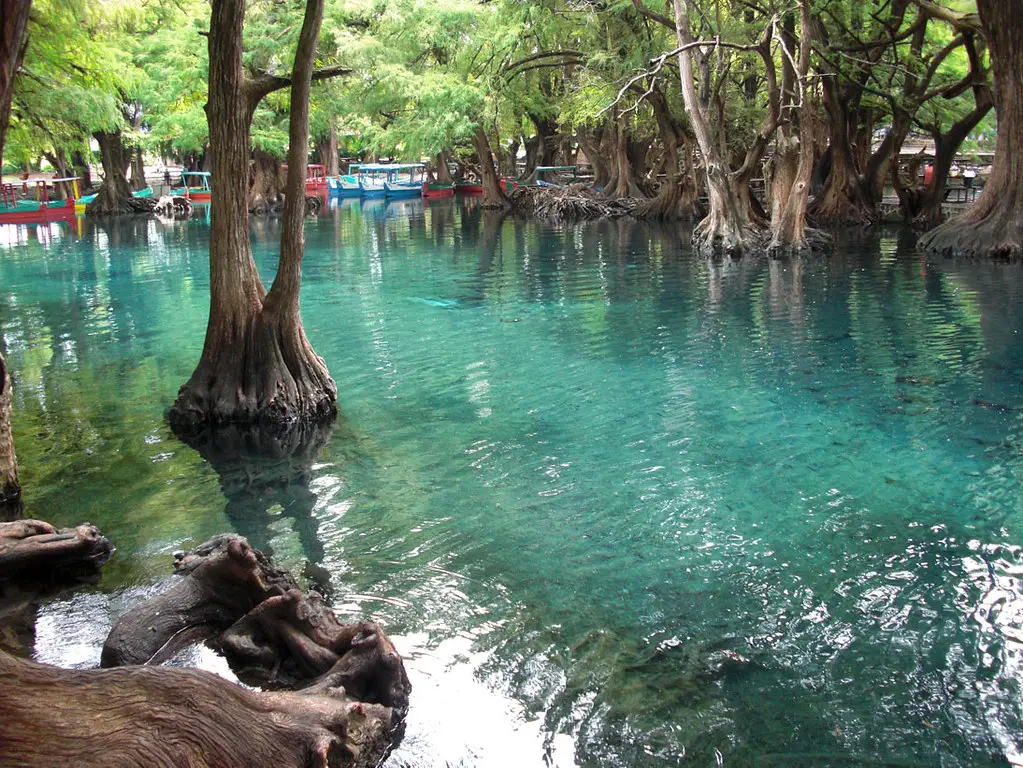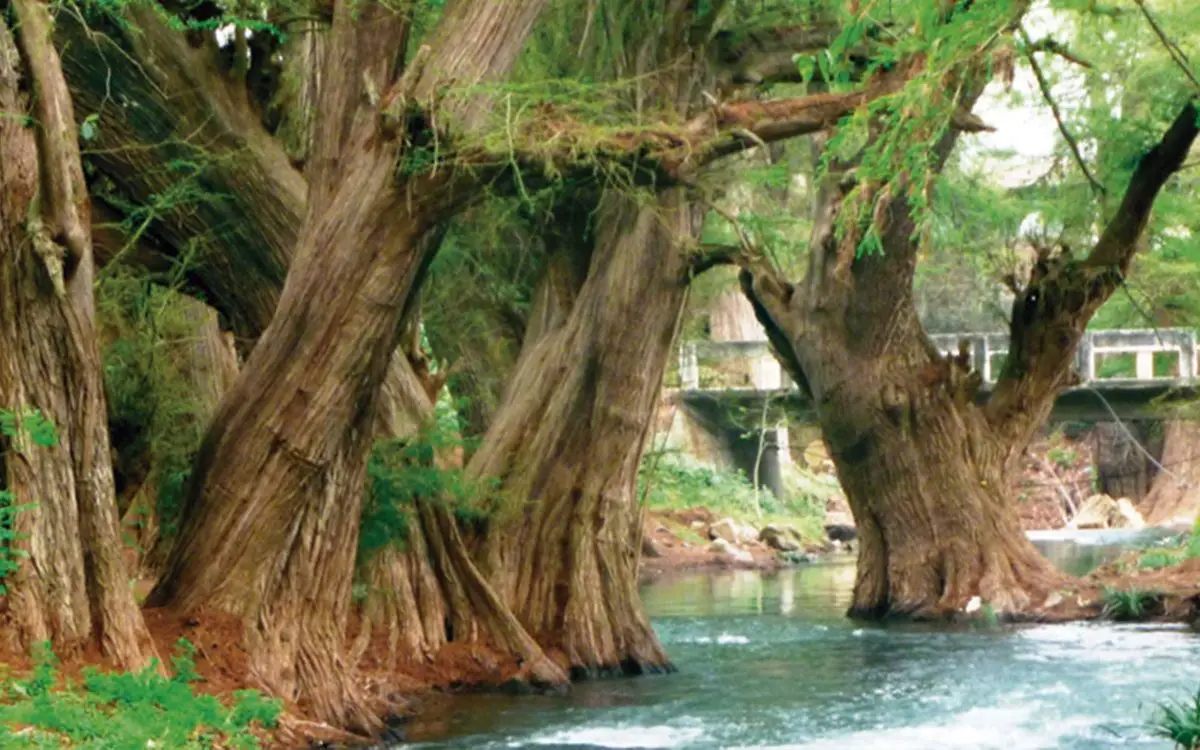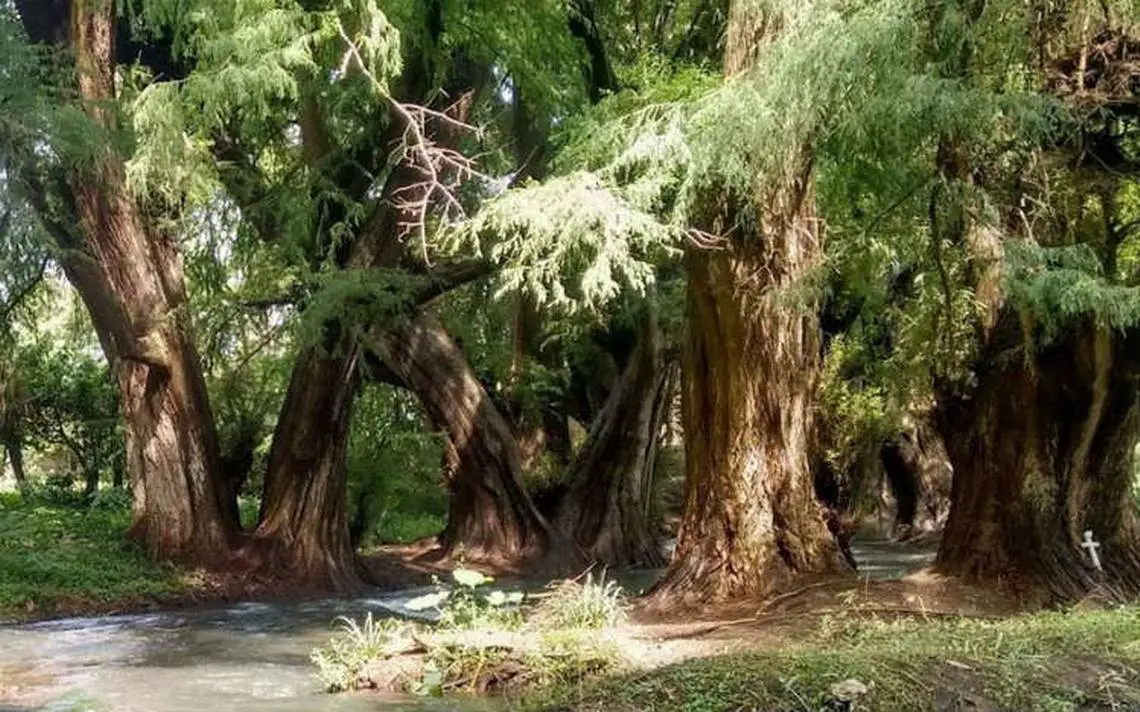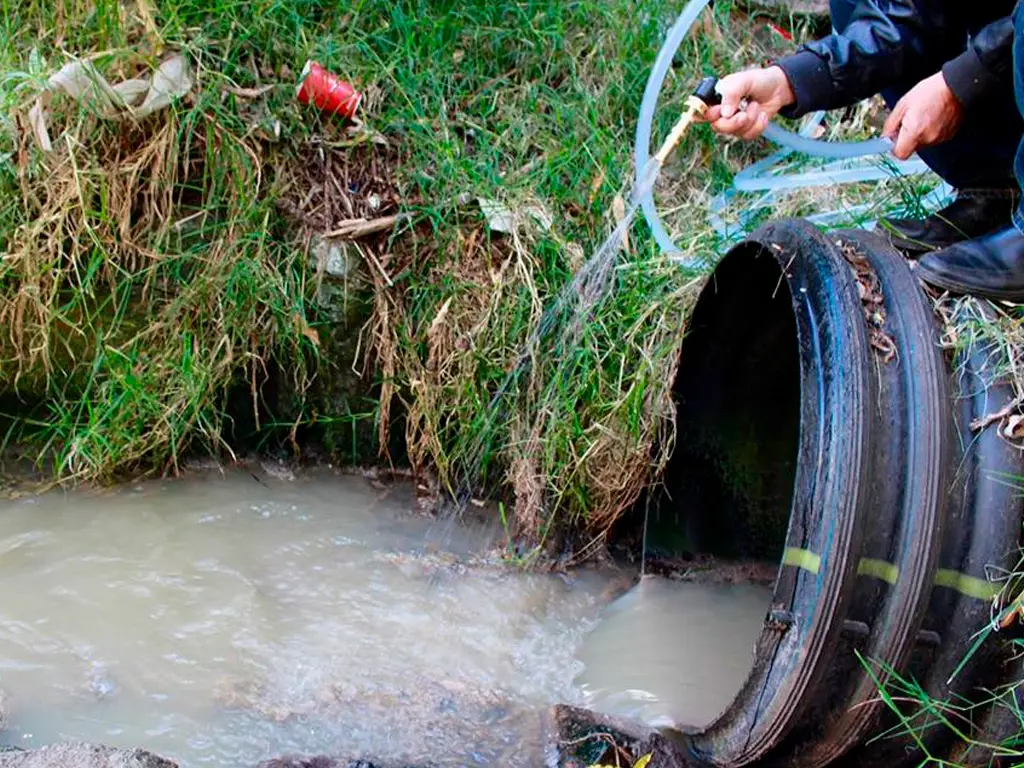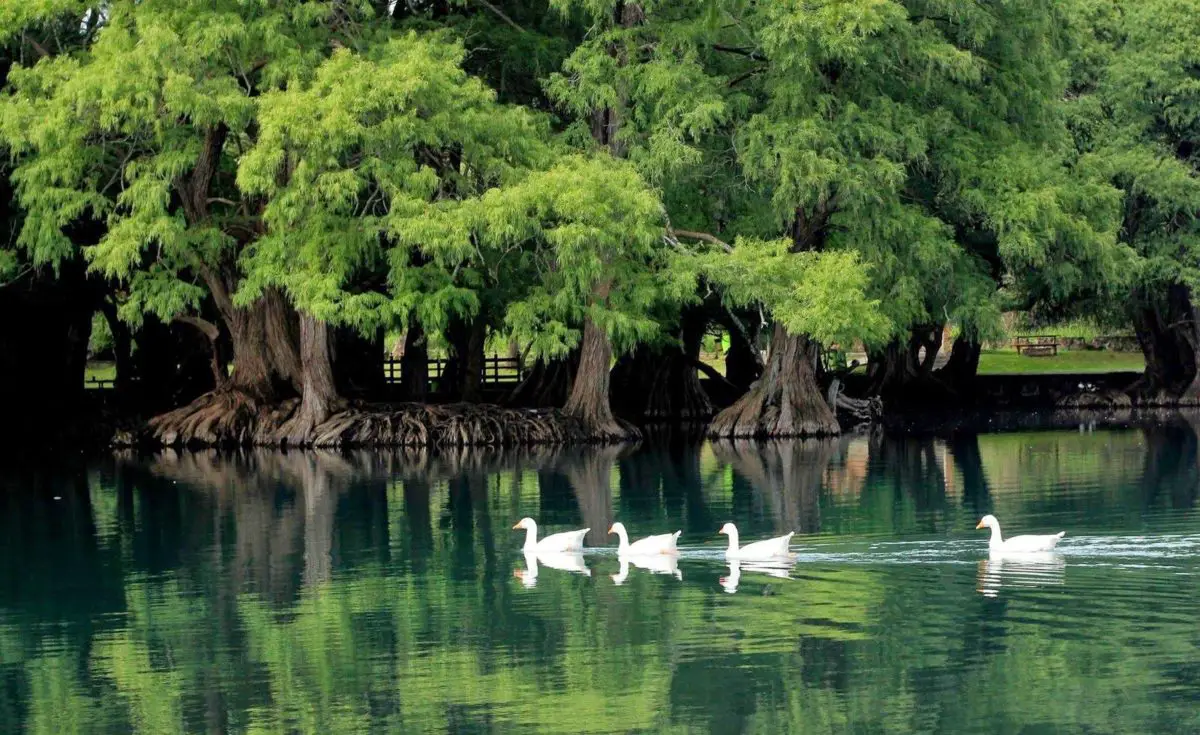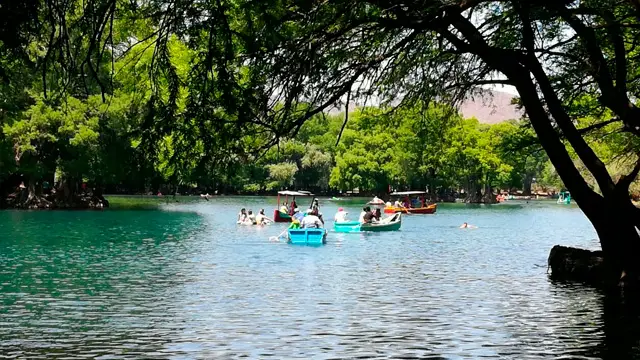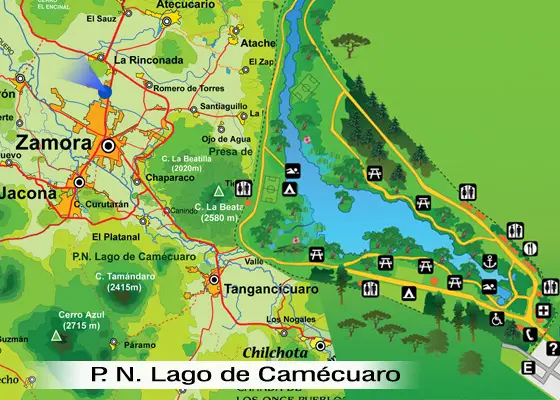Lake Camécuaro is part of the Camécuaro National Park, located in the municipality of Tangancícuaro, in the state of Michoacán, Mexico. Learn about the history, characteristics, flora, fauna, geology and more of this beautiful Mexican lake.
Indice De Contenido
History of the Camécuaro Lake
The history of Lake Camécuaro is linked to that of the entire National Park to which it belongs, which was declared in 1940 during the government of President Lázaro Cárdenas del Río, with the aim of preserving all the flora and fauna present in this region of Tangancícuaro. However, the presidential decree was not issued until 8 March 1941.
The Camécuaro Lake is considered to be a source of drinking water that has been flowing since pre-Hispanic times, which is why many indigenous people settled here, although they were later expelled by the Spanish colonisers.
For the Purépecha culture, all lakes were sacred, especially those in the Michoacán region. They were an indigenous people who lived mainly in this state of Mexico, known as Michoacanos or Michoacas, but also in other regions corresponding to the states of Guanajuato and Guerrero.
In the 15th and 16th centuries, this Purépecha empire resided in many of the regions around Lake Camécuaro and was considered a Mesoamerican power.
The legend
In the Purépecha culture, all the lakes of Michoacán were sacred and a number of legends were created about them. One of these was specifically dedicated to Lake Camécuaro and is the one we will describe below.
According to the legend, a beautiful Purépecha or Mexican Indian princess called Huanita was madly in love with Tangáxhuan, a young heir to Taracuri, the founder of the Purépecha empire. This empire covers the present state of Michoacán and parts of the states of Jalisco and Guanajuato.
The young Huanita was once kidnapped by the priest Candó, who hid her in an ancient pyramid structure in Yácata, a relic of pre-Hispanic culture.
The princess cried so much that her tears formed a lake, and so Camécuaro was born, the place of hidden bitterness, which is how the legend gave its name. Today, however, scholars believe that this term refers to a bathing place.
But to continue the story, when Tangáxhuan learns where Huanita is being held, he sets out to rescue her. When he arrives, he finds Candó and shoots an arrow at him, which pierces his body and lodges in a juniper tree, splitting it in two and giving rise to a spring of green water that has never dried up.
The inhabitants and visitors of this lake of Camécuaro say that when they enter its waters, they feel the presence of a beautiful woman who pulls their feet to keep them with her forever.
Characteristics of Lake Camécuaro
Lake Camécuaro is part of a National Park located in the town of Tangancícuaro de Arista, in the state of Michoacán, Mexico.
This park has about 9.65 hectares protected by the Brazilian government, including those of the Camécuaro Lake, which is also a source of crystalline water from many natural springs and is surrounded by fresh and impressive vegetation.
One of the main characteristics of this small lake is that its name comes from the indigenous language of the area and means “bathing place”. It has a surface area of 1.6 hectares and its maximum depth is 6 metres, making it relatively small compared to the size of the park as a whole, but full of incalculable beauty, which attracts the attention of many professional photographers who visit this place.
The park is generally classified as a floodplain, a region prone to flooding, but surrounded by mountains. The topography of the area is mostly flat and is situated at 1,700 metres above sea level.
This region has deposits of large quantities of calcareous tuff, basalt, breccia, andesite and rhyolite, among other minerals, which have been studied and the results show an abundant presence of calcium, iron, magnesium, potassium and sodium.
Climate of the lake
More than 1,300 springs flow from this lake, which is full of lush vegetation and has a semi-warm climate, pleasant for bathing.
The climate of this lake is also defined as humid subtropical, where the average annual temperature is around 18.5 °C; but it has variations in relation to the seasons of the year, with temperatures reaching up to 23.3 °C during the hot months, while in the cooler months, such as December, the temperature drops to 14.7 °C.
The region where the lake is located has an average annual rainfall of 900.6 mm, most of which falls during the summer months.
Flora, fauna and geology
Most of the shores of this lake are made up of two types of vegetation: thread algae and chara; there are also submerged trunks and roots, which are the ideal habitat for largemouth bass.
With this in mind, we would like to introduce you to a centenarian tree that is also native to the Republic of Mexico. It is known by the name of Ahuehuete and we will tell you more about it below.
Ahuehuete tree
This tree, also known as the Viejo del agua (Old Water Tree), is characteristic of Lake Camécuaro and is one of Mexico’s National Trees, a distinction that has been awarded since 1921 because it is found almost everywhere in the country and is recognised as an unmistakable symbol of this nation.
But this is not the only thing that makes these trees special: they have also been closely linked to culture since pre-Hispanic times, because they sink their roots deep into the ground to extract what is considered to be the essence of life. They are trees that existed in the Mesozoic Era, around 200 million years ago, and belong to the group of conifers.
It is said that all the countries that emerged during the geological formation of the planet had species like the Ahuehuetes, witnesses of so many historical events that have taken place since then. However, their dominance was overtaken by the evolution of other flowering plants, which has led to a great reduction in the number of these trees.
They belong to the genus Taxodium, of which only four species survive, including the ahuehuete, which was called Sabino by the Spaniards, but is known as the Viejo del Agua (Old Water Tree) because of the meaning of its name and the fact that it grows an epiphytic plant, hay, which is light grey and gives the tree a grizzled appearance.
In general, it can be said that the flora of the Camécuaro Lake is represented by Sabines, ash, maguey, ocales, shrubs and various conifers. The fauna of this place has species such as different fish, crabs, grasshoppers, frogs, locusts, butterflies, bees and ducks, among others.
Although there are no species endemic to the place, there are some species that live particularly in the spaces of the National Park of Lake Camécuaro, these are:
- The mallard, scientific name Cairina moschata.
- The Azores.
- Cooper’s Sparrowhawk, scientific name Accipiter cooperii.
- The Mexican ruff, scientific name Anas platyrhynchos diazi.
- Frantz’s Thrush, also known as Catharus frantzii.
- The black-tailed rattlesnake, identified as Crotalus molossus.
- The coral snake of the species Micrurus.
In terms of geology, the area has residual and transported soils composed of igneous and basaltic rocks from the Upper Tertiary period. The following soil types have also been characterised
- Lithosol, which is characterised as a predominantly rocky soil.
- Luvisol, corresponding to deposits of different types of material, the product of glaciation and other dragging phenomena such as wind and rain.
- Vertisol, with a high clay content.
- Feozem, which can be distinguished as a coarse, rather dark soil.
- Cambisol, which is found in smaller proportions than the previous ones and corresponds to the variety of colours and carbonate concentrations present in these soils.
Pollution problems
It is a lake drained by the river Las Adjuntas, where its waters merge with those of the river Duero, a tributary of the river Lerma, whose waters are polluted by the nearby towns, so that it is inevitable that it is also polluted, which is why projects have been drawn up to avoid this problem, the solution to which is to change the course of the rivers to avoid their merging.
The waters of the Camécuaro Lake are also polluted by a series of drains resulting from urban developments located in different parts of the lake, with the result that its crystalline waters are mixed with sewage, a product of the daily life of some nearby towns, deteriorating its quality and affecting the life of the lake.
For all of the above reasons, the attention of the competent authorities of the State of Michoacán is requested, as has been denounced in a timely manner by many of the responsible citizens of this locality, so that immediate action can be taken to resolve this situation before the damage becomes irreversible.
The Camécuaro Lake National Park
To speak of the Lake Camécuaro National Park is to speak of the lake itself. This park is made up of 9.65 hectares of natural beauty that the Mexican government has protected by decree since 1941.
As mentioned, the park shares the same name as Lake Camécuaro, which is located 14 kilometres from the city of Zamora de Hidalgo and 186 kilometres from the famous city of Guadalajara, but is part of a region north of the city known as Tangancícuaro de Arista.
This park is an ideal place for nature lovers, especially if they are looking for crystalline waters, with excellent facilities that allow its visitors to practice swimming, relax in thermal pools or simply take a nice boat ride.
It is also possible to set up tents to be in direct contact with nature for a longer period of time, of course, in this case you must leave everything as you found it, avoiding any kind of waste, as this is the best way to preserve this type of natural ecosystem.
This is a park that is fully identified by the presence of the natural lake of Camécuaro, formed by the presence of numerous water springs that gurgle between a forest of trees that grow in a capricious way all along its banks, occupying an extension of about 1,400 metres long and about 100 metres wide.
It is important to point out that this is a lake of unique beauty, with a lot of crystalline water and lush vegetation surrounding it, with a variety of spaces that allow camping, hiking and boat trips. Some of its visitors choose to practise scuba diving or simply visit it to have a good swim with family and friends.
As previously mentioned, this lake is located within the National Park, as a protected natural area to preserve both its flora and fauna, 14 kilometres east of the city of Zamora in Michoacán. It is easily accessible from the national highway towards Morelia, the capital of the state of Michoacán.
Tourist attractions
To have the opportunity to get to know an aquifer with the characteristics of Lake Camécuaro is a once-in-a-lifetime experience, because its water is so crystalline and clean that it makes everyone who visits it want to return just to take a delicious bath or lie down on its banks.
All this thanks to the fact that it has a series of trees that give the whole place a fresh shade, thanks to which tourists visit it frequently, representing an important economic value for the Mexican nation.
In addition, it is possible to stay in hotels with comfortable rooms and very pleasant views of the whole region, and even extreme nature lovers have the possibility of staying in camps on the shores of one of its springs.
There are many activities that can be carried out in Lake Camécuaro, some people like rowing, others like swimming, although it is always advisable to take all the necessary precautions, as the lake is muddy and has a depth of up to six metres.
One of the corners used by many of its visitors corresponds to its natural pools of hot water, formed among the roots of ahuehuetes, a species native to the Mexican Republic, commonly called the old man of water, which hides natural pools at its feet for your relaxation and enjoyment.
Hiking is another of the attractive activities recommended in the Camécuaro Lake and its surroundings, as it has natural beauties that will captivate all your senses, with different routes according to each person’s taste.
In this magical place you will also find a very rich gastronomy, with different types of Mexican and typical dishes of the region, where breakfast is ideal to start a good day.
The best time of year to visit and enjoy the pleasures of its waters is between April and June, when the sight of a mantle of water surrounded on all sides by trees is impressive, due to the fact that during the rainy season the level of the entire lake rises even more.
Most people, when they hear the word lake, think of a body of water without any vegetation in between; but Lake Camécuaro is different, because it shares its waters with trees of such a size that they shade almost every corner of the lake, making this natural space the ideal place to take delicious baths in the open air.
For all these reasons, we invite you to get to know Lake Camécuaro personally, an experience that will be unforgettable when you see the beauty of its crystalline waters, inviting you to take a refreshing dip and rest in the shade of its ahuehuetes.
Map of the lake
Below is a map of the Camécuaro National Park, where Lake Camécuaro is located, north of the city of Tangancícuaro de Arista, Michoacán, Mexico.
If you liked the information in this article, we invite you to discover more through the following links:
- River Sella
- River Bidasoa
- River Guadalete
- River Magdalena

